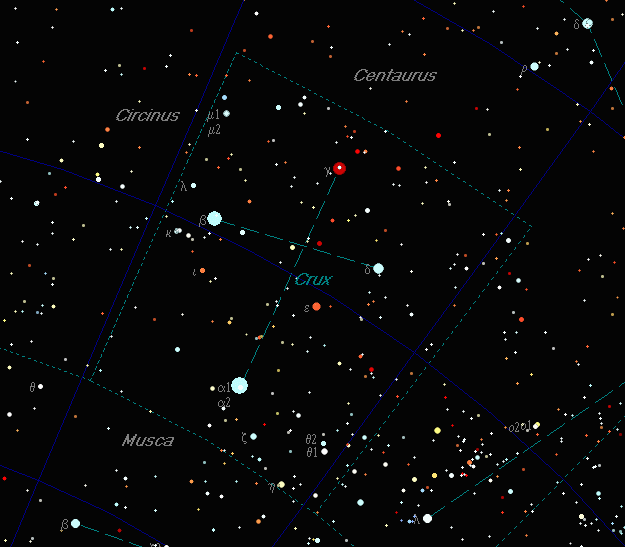by Dave Blane — 2014 February 24
This magnificent gem is located at the foot of the Southern Cross. Its double nature was first noticed in 1685, but by whom?
There is some disagreement in the literature but a recent reference states that it was first noted by French Jesuit priest Guy Tachard, who was journeying to Siam and en route stopped in Cape Town, where a temporary observatory had been set up. However, Dunlop is officially credited with the discovery and α Crucis is number 252 in his catalogue of double stars.

Alpha Crucis (or Acrux) is actually a multiple star system located 321 light years the earth. The two components, α1 (α Crucis A) and α2 (α Crucis B) are separated by 4 arcseconds at a position angle of 112°. The brightest, α1 is magnitude 1.3 and α2 is magnitude 1.6, both hot class B stars, with surface temperatures of about 28,000 and 26,000 K respectively. Their luminosities are 25,000 and 16,000 times that of the Sun. The orbital period of α1 and α2 is probably 1500 years or more and little change has been noted since the first recorded measures in 1826 (see table below).
α1 is itself a spectroscopic binary star, with its components thought to be around 14 and 10 times the mass of the Sun and orbiting in only 76 days at a separation of about 1 AU. The masses of α2 and the brighter component of α1 suggest that the stars will someday explode as supernovae.
Another magnitude 4.9 class B star, α Crucis C, lies 90 arcseconds away from the triple star and shares α’s motion through space, suggesting it may be gravitationally bound to α Crucis. It is therefore generally assumed to be physically associated with α Crucis.
Through a 6-inch refractor A and B appear brilliant white and are clearly resolved at 150x with black sky between the components. The widely separated A and C components are visible in 10 x 50 binoculars, and a 3-inch scope will even show the A-B pair in daylight!
The ASSA Deepsky Section would be interested to hear from anyone that has managed to do this.
Table 1. Components of alpha Crucis
| component | year | number of measures | PA | angular separation | mag 1 | mag 2 | spectral class | code |
| AB | 1826 | 73 | 121° | 5.6″ | 1.25 | 1.55 | B 1 V | DUN 252 |
| 2012 | 111° | 3.6″ | ||||||
| AC | 1826 | 13 | 202° | 90.1″ | 1.25 | 4.86 | B 4 IV | DUN 252 |
| 2008 | 203° | 90.6″ |
Table from the Washington Double Star Catalog giving position angles and separations of the components
- Browse the Newsletter Archives.
